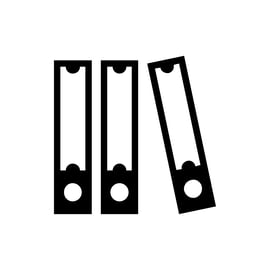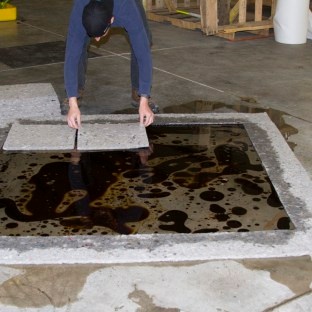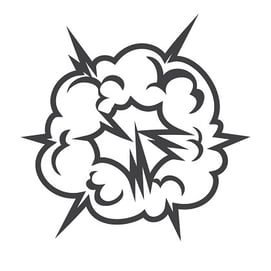
Employee turnover is the worst.
Not only is it a hassle to find and hire new employees, but then you have to retrain new ones. Turnover may not be high in your specific industry. But, when an experienced worker transitions—they can leave behind a few gaps that must be filled as quickly and efficiently as possible.
Don’t let spill response be one of those gaping holes. If you work in industrial situations like oil and gas, electricity, utilities or maintenance you know that it can be messy, dirty, oily and dangerous. Heavy equipment, fleet vehicles and machinery all have the potential to leak or spill oil and fuel. This means your next spill could happen at any moment.
Whether it’s a pesky little leak or a massive spill, you need a fast and effective spill response plan. Are you concerned that your new hires aren’t prepared to properly attend to a spill? Is all this worrying giving you a stress headache?

Have no fear! We have tips to help you get your SPCC (Spill Prevention Control and Countermeasure) plan in motion.
Get new workers up to speed with your SPCC plan! Here’s how:
-
Of course, training is the most important part of any SPCC plan. It’s not enough to jot down a few instructions and expect that to suffice. You may have developed and implemented a SPCC plan. That still doesn’t mean you are compliant. Training employees may be one of the most overlooked parts of the entire spill response strategy. Train. Retrain. And then train again.
Train. Retrain. And then train again.
If you have an employee that may come into contact with oil, they need to be thoroughly trained.
Training should always start with an overview of SPCC regulations and a review of plans specific for the site. Go over the steps of proper operation, maintenance and inspection for oil storage, transfer, containment and cleanup. Make sure to clearly instruct workers and show them what actions are required in the event of a spill or leak.

One overlooked part of training is teaching workers how to assess risk.
Before any member of your team responds to a spill, they need to assess the situation. Teach them how to look for hazards, health risks and danger zones. This must be something they know inside and out. Just kinda knowing something isn’t enough. When high intensity situations arise, common sense has an interesting way of skipping out the back door. Unless we’re prepared.
Instruct workers on how to use appropriate safety equipment and PPE when necessary. And, make sure they know when to evacuate and just wait for the professionals. -
Nothing is worse than knowing what you need to do, but not being able to find the things you need to do it. Organization is everything. Whether in a facility or on the road, you need easy access to your tools and equipment. Messy work vehicles or small spaces are some of the biggest issues facing the mobile industrial worker. Be an organizing and labeling maniac
Be an organizing and labeling maniac
Fortunately, that’s an easy fix.
Organization strategies exist that can help workers maximize their storage space. They need to be sure they have all the items they need, without having to return to the facility.

Clear out the clutter.
You can do this by having your employees regularly remove all the unnecessary stuff that’s just taking up space. Then, they can arrange items so they are easier to find and store. Use labels and shadow boards to keep important items like sorbents, tools, PPE and first aid accessible. -
Make sure you create written procedures so there is never any confusion. Every step of your process should be documented clearly and recorded in a way that employees have access to it. Please don’t leave this super important information locked up on some computer program. Keep an SPCC binder handy to track and record spills and any other important information that your staff needs. Create a paper trail.
Create a paper trail.
Workers should know how to respond appropriately to a spill, but it doesn’t hurt to have written procedures that can be used in a pinch. Your SPCC binder can also be used as a guide for your training sessions.

Use your SPCC binder to guide your trainings.
Want to know what else should be in this binder? The proper protocol for reporting spills to governing agencies. Remember, spills are time-sensitive and must be reported within a timely manner. Check your local and federal regulations for details! -
Keep workers motivated by rewarding those who complete your spill response training sessions. You can keep track of employee training in...your handy SPCC binder! Day to day tasks have a way of taking priority over training. After all, your employees aren’t spill contractors by trade. They have a job to do. Help them do it. Reinforce and reward trainees
Reinforce and reward trainees
By tracking the education and trainings workers have completed, you can have a better overall view of who is ready to take on a spill...and who isn’t.

Use rewards to motivate your team.
Reward employees who take training seriously. There are many ways to reward workers for a job well done. Some people are motivated by acknowledgement and praise alone. Others may be more motivated by things they can show off like hard hat stickers, tee shirts or coffee mugs. Get the whole team to work together by creating team exercises.
Competition is also a strong motivator and bragging rights can be worth their weight in gold. -
That’s right. The buck stops with you. If you take spill response training seriously, so will your employees. Take the time to be involved with their training. Remember, this training isn’t only for compliance sake. It’s for the safety and well-being of your crew. Lead by example
Lead by example
Worker safety should always be the #1 priority. If they can safely and effectively respond to an oil spill, other factors like regulation will fall into place.

Get your veteran employees involved in training. They've "been there, done that".
Another tip for getting your new employees in line with SPCC protocol is to let your veteran workers have a stake in training. They’ve been there, done that. And, they may have important knowledge to pass on to new workers—knowledge that only comes from years of experience. There’s a saying that book smarts only goes so far. The rest comes from experience.
When it comes to the responsibilities of the industrial workforce, that couldn’t be more true.
Still don’t think spill response training is important?
.jpg?width=600&name=team%20plan%20(2).jpg)
The Environmental Protection Agency (EPA) requires companies to have a SPCC plan. Your plan should be designed to prevent and contain leaks and spills. The problem is that these plans can be complicated and teaching them to new workers is challenging.
If you have any employees who are unsure about how to react in a spill situation, you could be putting your company at risk. Spills can cost a company time, production, steep fees and regulatory fines—not to mention the burden of mitigating any environmental effects of a spill.
With an effective spill plan in place, you can reduce or avoid:
- Potential legal fees and regulatory fines
- Long-term damage to ecosystem and environment
- Health and safety risks
- Bad publicity
- Some “spillers” have even seen their company’s stock price take a hit!
 |
Not only that, slips, trips and falls are the cause of 1 in 6 lost-time injuries! Effective spill containment and cleanup is a no-brainer for workplace safety. |
Are you confident that your team has what it takes? Are you sure that all of your employees (experienced and inexperienced) can confidently respond to a spill situation? If you need more detailed, step-by-step tips explaining what your Spill Prevention, Control and Countermeasure (SPCC) plan should look like, click here.
Remember the basic steps of spill response:
- Assess the risk: Look for visible and invisible hazards before responding to spill.
- Protect yourself: Use appropriate personal protective equipment.
- Stop the source: Tighten valves, plug leaks or weld holes once safe.
- Confine the spill: Use spill control products to limit the spread of the spill.
- Evaluate and cleanup: Review company policy and use appropriate cleanup materials.
- Decontaminate: Set up decon stations and dispose of contaminated items properly.
- Report: Make sure to report to regulating bodies in a timely manner.
Your new hires can be a wonderful asset. Give them the best chance at success. Provide them with adequate education, training and a bit of your wisdom. When it comes to proper spill response, there’s no such thing as too much information.
 |
Follow these tips and that pesky headache will simply...disappear. |
And just think, new hires are like a blank canvas. You can teach them the right way to do their jobs. When was the last time you had that opportunity?
Do you have interesting or scary tales about times your new employees came face to face with an oil spill situation? What did you do to make sure that never happened again?
If you have any questions on finding the right spill control products that meet your needs, just ask. Give us your crappiest job and we will help you find a better way.
Topics: Spill Response
